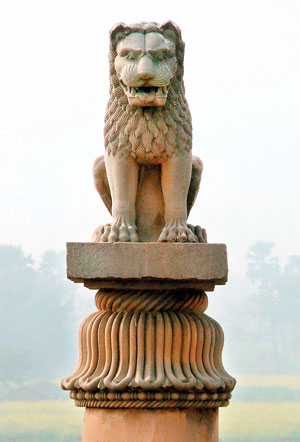Asoka pillars – symbolic of the spread of Buddhism

The Asoka Pillar at Vaishali
Vesak commemorates three events, the Birth, Enlightenment and Passing Away of the Buddha, an event recognised as the most important religious festival of Sri Lanka.
This year the state-sponsored Vesak festival is at the ancient Naigala Raja Maha Viharaya in the Hambantota District, presided over by President Maithripala Sirisena. The ordination of 35 youth as monks takes precedence at this event. With UN giving international recognition to Vesak, a World Vesak Day is held which is in progress now in Bangkok attended by Minister of Buddhist Affairs Wijedasa Rajapaksha, as Sri Lanka’s representative. He is scheduled to formally request the holding of next year’s World event in Sri Lanka.
The tradition of commemorating events and the establishment of places associated with the Life of the Buddha as sacred places was begun by Emperor Asoka around the same time he introduced Buddhism to Sri Lanka. During his reign (circa 272-237BCE) which was over 200 years since the Passing Away of the Buddha (circa 544BCE,) places associated with the Buddha had fallen into oblivion. Asoka, who was horrified at seeing the devastation caused by his conquest at Kalinga, converted to Buddhism eight years after his coronation. His life there onwards was dedicated to the promotion of Buddhism, while governing the empire according to the teachings of the Buddha.
His deep devotion to Buddhism led him on a tour of discovery of the locations which signified Buddha’s Life. Thus he instituted Dhamma tours or pilgrimages to the sacred places. He visited Lumbini ten years after his coronation and discussed Dhamma with the people of Lumbini. It was however, a further ten years later that he built four sthupas and erected a Pillar at Lumbini where was carved : “Twenty years after his coronation, the Beloved-of-the Gods, King Piyadassi visited this place and worshipped because he the Buddha, the Sage of the Sakyans was born here. He had a stone figure and a pillar set up because the Lord was born here. The village of Lumbini was exempted from taxes and was required to pay only one eighth of the produce.”
The stone pillar with a figure of a horse at the top, still stands at Lumbini as a symbol of the Emperor’s fierce devotion to the spread of Buddhism.
The Emperor took special care of the Sambodhi or the Mother of the Sri Maha Bodhiya at Buddha Gaya under which the Buddha attained Enlightenment. The emperor visited the Maha Bodhi often tending and venerating it. At Buddha Gaya he erected a stone pillar crowned with animals. Chiselled as a single piece of stone, (his pillars had an average height of 40-50 feet (12-15 metres) with each weighing up to fifty tons) on this masterpiece of Mauryan art the Emperor inscribed his edict in veneration of the Buddha.
Among these magnificent Asoka columns, the most popular however, is the Pillar at Sarnath, formerly Isipathana, located near Varanasi, where the Buddha delivered his first sermon – Dhamma-chakkapavattana Sutta in which he taught the four Noble Truths to his first disciples. And Buddha himself stressed the importance of Isipathana as a place which should be visited by Buddhist devotees. Emperor Asoka erected the Sarnath Pillar with four lions facing the four directions at its top which India, on gaining Independence from the British, adopted as its National Emblem. And the wheel – “Asoka Chakra” carved at its peak, India placed in the centre of the Indian flag.
In contrast to the Sarnath Pillar, the Asoka Pillar at Vaishali, has a single lion with no transcript inscribed on it. It was at Vaishali that the Buddha preached his last sermon and set out to Kusinagar knowing his end was near. The single lion on the Vaishali Pillar faces the north, the direction Buddha took on his last journey.
When Buddha Passed Away, his ashes were divided and buried in several sthupas erected by the kings and those who received the ashes. Some of the ashes King Ajasattha enshrined in the Drona Sthupa. Asoka opened up the Drona Sthupa, collected some of the bodily relics and placed them in many caskets. He constructed sthupas such as the Mahasthupa at Sanchi and in various towns and cities enshrining the relics in them, making them pilgrimage sites for Buddhists. Sthupas, Pillars and edicts thus represent the first physical evidence of the Buddhist faith.
Although we confine ourselves to Asoka Pillars erected at places associated with the Buddha, there had been edicts inscribed on 30 stone pillars and earthbound rocks, according to historical records. Only ten of them have been discovered in the 19th century in what is now India, Pakistan, Nepal, Afghanistan and Bangladesh which offer an insight into a ruler’s attempt to establish an empire based on righteousness. These edicts written in Prakrit, Sanskrit, even Greek and Aramic in simple and direct style, had been placed along trade routes and in border cities for the masses to read.
While lions adorn most of the pillars, probably to symbolize the fact that Buddha was born into the Shakya or lion clan, at the top of each pillar is an inverted lotus flower which is deciphered as a flower that rises from the muddy water and blooms unblemished on the surface. The lotus – an analogy for the Buddhists, symbolizes the endless cycle of birth and rebirth. With the help of the Dhamma, one could be released from Samsara through the following of the four Noble Truths.
Emperor Asoka is credited as the first ruler who attempted to develop a Buddhist polity and proceeded to establish a “Buddhist kingship.” In Sri Lanka,we saw the concept being followed throughout history.


